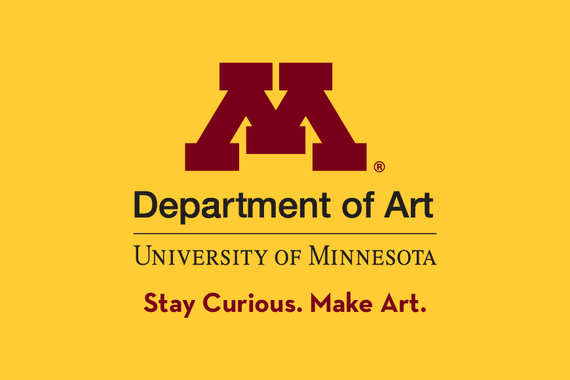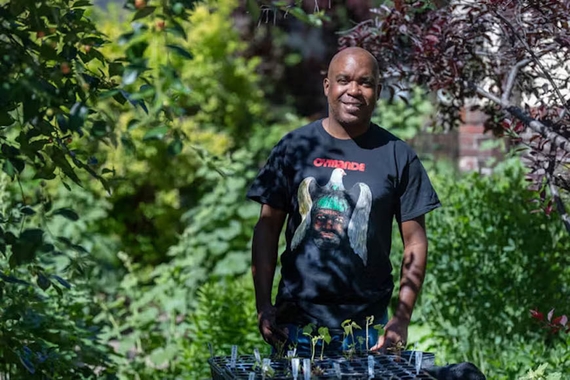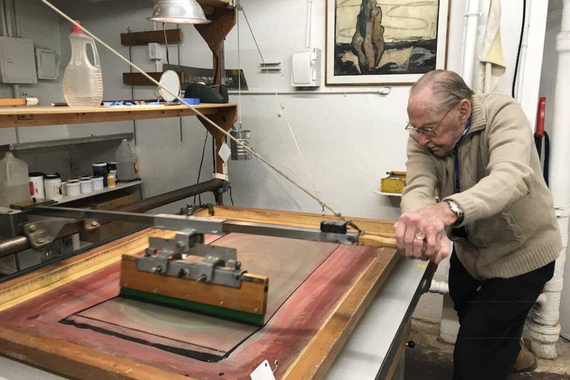Where Are They Now: Art Alum Julie Olson Rand
Hi Julie! You graduated in 2001 and now find yourself back at the U, working on campus. Can you tell us more about what you do?
Sure! I am working at the Disability Resource Center, or DRC, and I’m the Associate Director of Access Programs. Because the U is so large, we have several units that make up the DRC — and I oversee the service provision side of the house. That includes the Interpreting/Captioning unit, Media Accessibility, and Testing/Access Assistance. Any student, faculty/staff or guest with a disability can utilize our services — so we’re the folks behind the scenes who make access happen!
I had a chance to learn ASL at the U, and later decided to get into the ASL interpreting field. I went to St. Catherine University for a second baccalaureate certificate program, and began my interpreting career —one I enjoyed for over 10 years.
I’m the meantime, I received my MEd from the U, and went on to become an adjunct faculty member at St. Catherine University in their ASL/interpreting program.
When my second child was born with a hearing loss, I began to ponder how I could infuse more advocacy work into my career. I began to seek roles in Disability Services, and landed an Assistant Director role at St. Catherine University. A few years later I was promoted to Interim Director, and then Director of our department.
The role I am in now at the U is a perfect marriage of my past interpreting experience and my work in Disability Services. I’m thrilled to be back at the U, and am beginning a PhD program this fall.
How do you think your time studying studio art prepared you for the work you do now? Was there a specific artistic discipline that you focused on during your time here?
At the time I was a student, we were not required to specialize — which I liked — so I was able to dabble in various art mediums. I ended up doing a lot of large scale abstract paintings in acrylic. And I fell in love with black and white film photography.
While I think an artistic eye is applicable in all areas of life — whether you’re decorating your home, or framing a snapshot of a majestic landscape or a portrait of a loved one… the aspect of my artistic lens that has been the most applicable in my workplace is creative problem solving. It’s not uncommon for employees who have worked in a department for a significant number of years to get into a rut — where the tried and true approaches for doing business become rote. But as we learned in the pandemic, there are many ways of doing business — and it’s those who can think outside the box and really engage with their teams to identify new ways to accomplish work goals — whether adjusting to new technology, hybrid workplaces, or reimagining how partnerships can create symbiotic relationships between teams — creative problem solving has been a boon in my career.
Do you still make artwork, or have you found another outlet for your creativity?
I have dabbled in various art forms and crafts since graduation. One thing I’ve enjoyed is learning how to make wheel-thrown pottery. And I have enjoyed knitting, felting, and sewing. I’ve participated in Art-a-whirl for several years, selling my pottery and fabric lined knit purses.
Also, I am a singer/songwriter and during my college days, I participated in an acoustic show, where three of us — all singer/songwriters would perform weekly. Over the years, I’ve performed solo and with a band — and while I currently have three young children, it would be fun to get back into it when the they get older.
Recently, my oldest daughter (who is 9 years old) and I have started a small business called Abel&Jule (our nicknames) where we sell the gemstone bracelets we make in adult, child and doll-sizes. It’s been fun sharing the love of creating with my family — and I hope to explore further art forms as my children get interested in different mediums.
What would you say to people who want to major in Art, but aren't sure how that might help them make a living?
I remember back when I was a student, and my peers would ask whether my parents were upset that I declared an art major. My response was — they’re thrilled I went to college! I feel strongly that education is for its own sake. Yes, many programs and majors prepare individuals for a specific career, but I can’t express how much value I have gained from having a liberal arts education.
My first office job out of college was with a property management company — where we managed the properties used for section 8 housing. That job required a bachelors degree — but it didn’t matter what major that degree was in. A college education — no matter the major — shows an employer that the graduate has learned to manage their time, juggle multiple demands on their time, and successfully came through with a set of applicable skills that will benefit any employer. As a college graduate with an art degree, you emerge with writing skills, critical thinking skills, creative problem solving skills, and a drive to make something where there was once nothing.
Once, when I shared that I had an art degree, an acquaintance responded, “what a waste!” While this may be the attitude of many people, it’s absolutely not true. Now, more than ever, your creativity will be a value add to your workplaces! Find a way to spin that into your job interviews and elevator speeches. You have a superpower!
Is there any advice you wish you could go back in time and give yourself as a student at the U?
One of the most difficult things about being an artist is that it can be very challenging to produce and market and sell your work — all independently. I wish I would’ve sought out a mentor to help me figure out how to keep my painting practice up, and to help me in booking art shows and promoting myself.
I don’t blame myself — these are skills I eventually learned as an ASL interpreter and am learning now as we build up our small business… but there was this sense of each of us going our own way, and I would’ve benefitted by some kind of collaborative with other artists after graduation.
I also had several friends and loved ones urge me to produce art, and while well-meaning, it didn’t usually correspond with the inspiration I needed to generate ideas and produce art. It became a pressure to do art simply because I’m talented at art, rather than for self expression or for the process itself — something I didn’t know how to articulate. So, my advice would be to honor where my art comes from — what nurtures my creativity, and to seek more of that — rather than to succumb to the pressures of well-meaning folks who don’t fully understand where artistic inspiration stems from. Truly, artistic inspiration comes from living a full life — so I’d tell my younger self — go live a full life, and the inspiration and creativity will come! Don’t forget to listen to that small inner voice — she will tell you when it’s time to create!
Oh — and don’t paint the edges of your canvases black. There’s a story to be told on the edges, Clarence Morgan would say.
For more information on and resources from the University of Minnesota Disability Resource Center, visit disability.umn.edu.



